

Machines & Machine Code. Autour de Scratch. Tutorial - Controlling The Real World With Computers. SQL Tutorial. Terminology, Syntax, & Introduction - A Beginners Guide to HTML & CSS. Before beginning our journey to learn HTML and CSS it is important to understand the differences between the two languages, their syntax, and some common terminology.
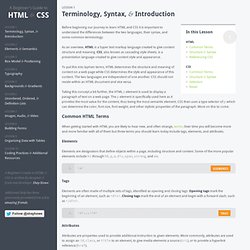
As an overview, HTML is a hyper text markup language created to give content structure and meaning. CSS, also known as cascading style sheets, is a presentation language created to give content style and appearance. To put this into laymen terms, HTML determines the structure and meaning of content on a web page while CSS determines the style and appearance of this content. The two languages are independent of one another. CSS should not reside within an HTML document and vice versa. Taking this concept a bit further, the HTML p element is used to display a paragraph of text on a web page. Common HTML Terms When getting started with HTML you are likely to hear new, and often strange, terms.
Elements Elements are designators that define objects within a page, including structure and content. Tags. Kidsruby.com. Android - A beginner's guide. Introduction This tutorial is a starting point for developing Android apps.

It will explain the very basics of the Android SDK (Software Development Kit) and how to use it with Eclipse. To understand this tutorial, you don't need to have any knowledge about programming in Java, but it might be helpful for further programming to understand the basics of object orientated programming. This tutorial explains Android beginners how to create an Android Project in Eclipse, work with resources, and create some first code. Setup Eclipse and the Android SDK If you don't already have a running environment to develop Android apps, follow the instructions at this link. Hint: PATH means the Path Environment Variable. Let's Get Started. Storytelling Alice. NOTE: Storytelling Alice is no longer supported.
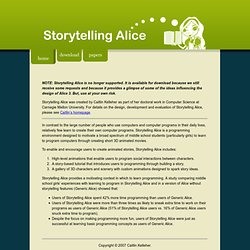
It is available for download because we still receive some requests and because it provides a glimpse of some of the ideas influencing the design of Alice 3. But, use at your own risk. Storytelling Alice was created by Caitlin Kelleher as part of her doctoral work in Computer Science at Carnegie Mellon University. For details on the design, development and evaluation of Storytelling Alice, please see Caitlin’s homepage.
In contrast to the large number of people who use computers and computer programs in their daily lives, relatively few learn to create their own computer programs. Alice.org. Imagine, program, share. JavaScript Programming for the Web — an online course at Learnable. JavaScript is the third and final pillar of modern web development (the other two being HTML and CSS).

It’s what makes the modern Web the interactive, animated, vibrant place that it is! No wonder so many web developers are finally getting around to learning it. JavaScript is the first programming language many people learn, and that can be a daunting prospect! In this course, veteran web developer Kevin Yank (co-author of the book Simply JavaScript) will guide you step by step on your journey. What you'll learn Javascript basicsCode Archiving.Creating your first javascript program. MIT App Inventor. Introductory Computer Science - App Inventor EDU. Course-in-a-Box - AppInventor.org: Democratizing App Building. Modules Quizzes Each module includes: Lesson plans and lecture notes Tutorials and Video Screencasts Conceptual worksheets Creative projects Test Questions Assigned readings from the App Inventor book Module Pathways Module 1, "Intro to Event-Handling" provides an introduction to the App Inventor environment and the idea that an app is a set of event-handlers.
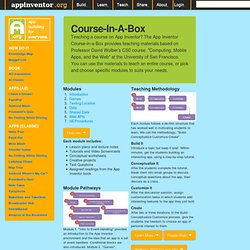
Conditional blocks are also introduced. Module 2, "Games", introduces the students to timing and animation and provides much needed work with manipulating properties and variables. Modules 4-6 focus on working with data, and this represents a significant conceptual leap as the programming becomes more abstract. Module X, "Software Engineering and Procedure Abstraction" is so named because different instructors will want to present it at different places in the curriculum. Teaching Methodology. Apps for Good. App Inventor Tutorials for Beginners. The Beauty of Joy of Computing Course, UC Berkeley Computer Science Video Tutorials, Daniel Garcia. Build Your Own Blocks (BYOB) (formerly BYOB) is a visual, drag-and-drop programming language.
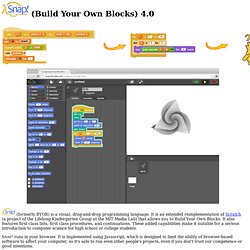
It is an extended reimplementation of Scratch (a project of the Lifelong Kindergarten Group at the MIT Media Lab) that allows you to Build Your Own Blocks. It also features first class lists, first class procedures, and continuations. Online Web Tutorials. Java Tutorials Learning Paths. Are you a student trying to learn the Java language or a professional seeking to expand your skill set?
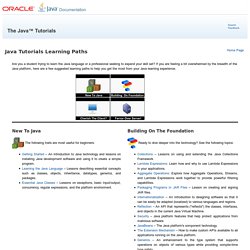
If you are feeling a bit overwhelmed by the breadth of the Java platform, here are a few suggested learning paths to help you get the most from your Java learning experience. Hello World! Computer Programming for Kids and Other Beginners. Author: Warren and Carter Sande Publisher: Manning, 2009Pages: 432ISBN: 978-1933988498Aimed at: Complete beginners, especially kidsRating: 5Pros: A motivating and well thought out approach, using free resourcesCons: Minimal explanation of complete listingsReviewed by: Sue Gee Computer programming is a skill that all children should have the opportunity to learn.
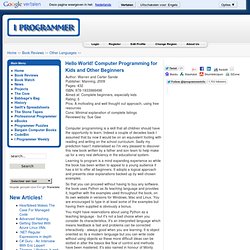
Indeed a couple of decades back I assumed that by now it would be on an equivalent footing with reading and writing on the school curriculum. 2012 » Young Rewired State « Learn to code.